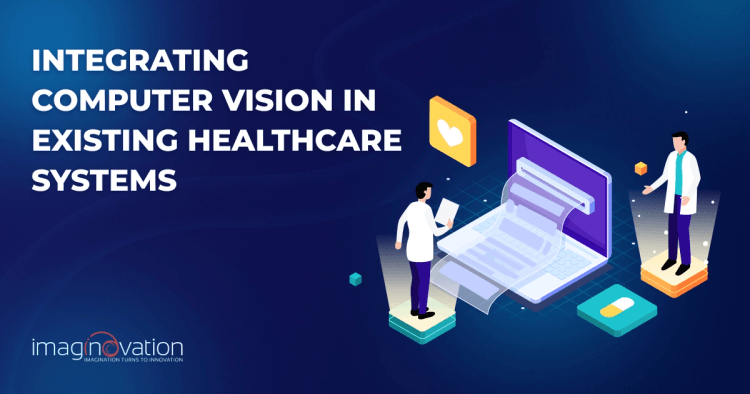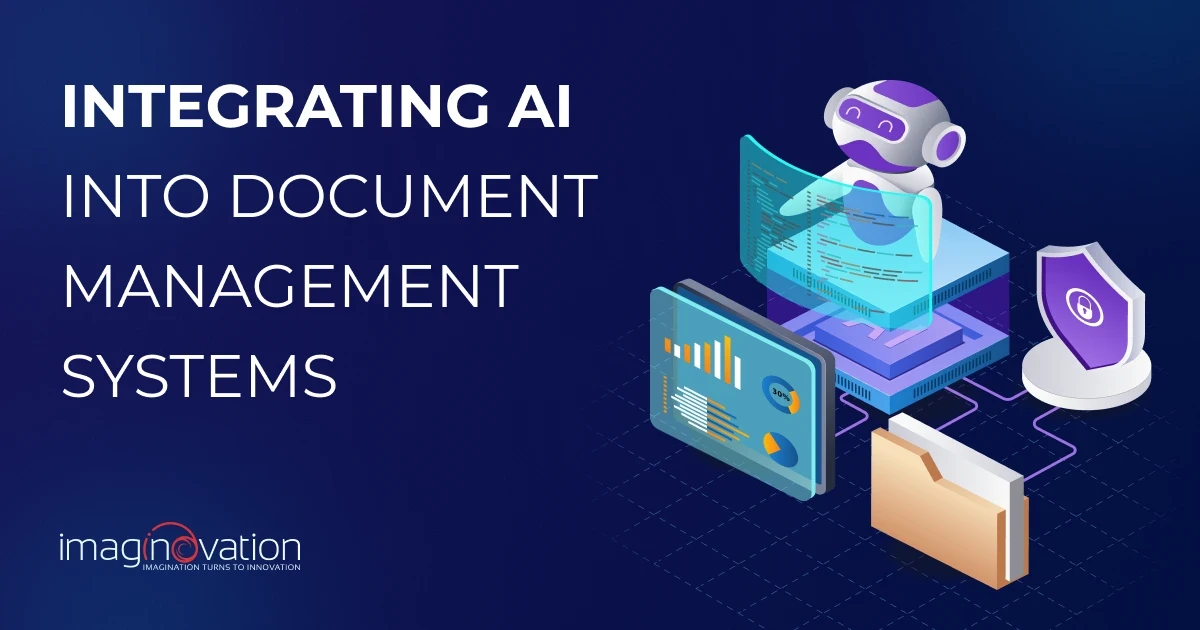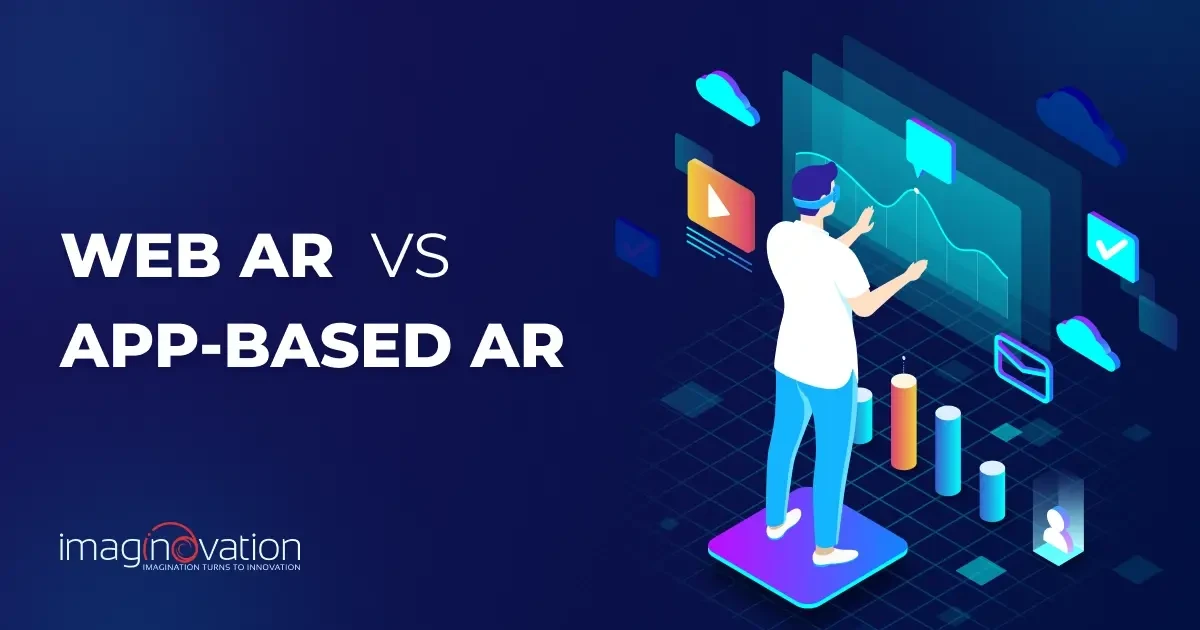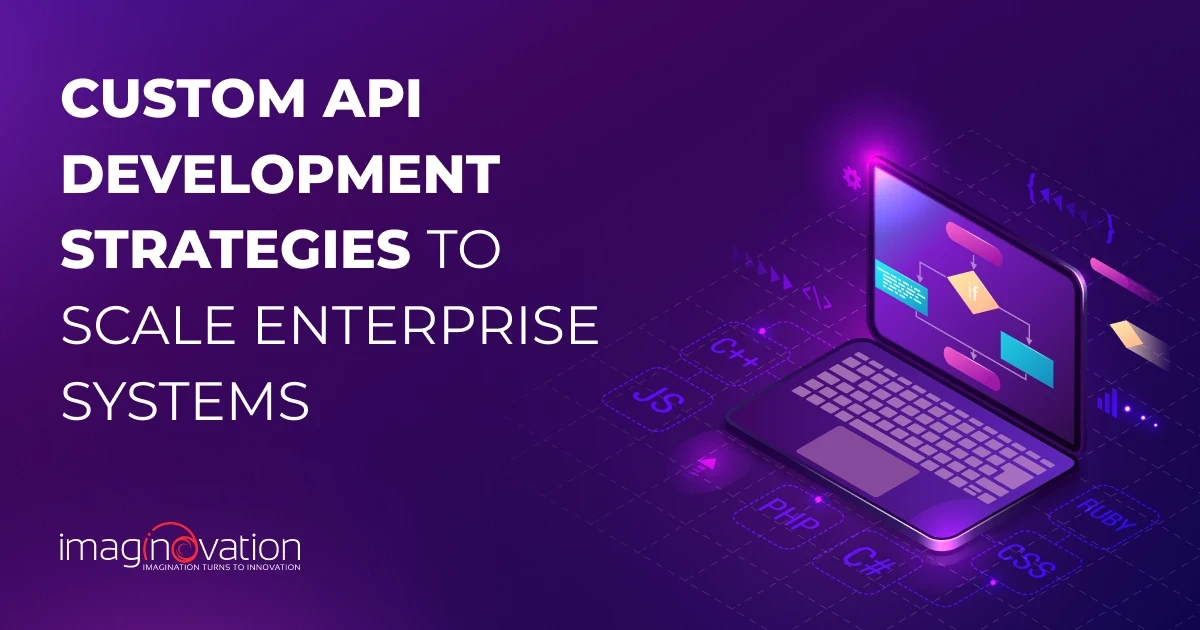The use of computer vision in healthcare is gaining serious momentum, and it’s easy to see why. With AI evolving rapidly, experts project that the market will reach around $53 billion by 2034, growing at an annual rate of over 35% (Source).
That kind of growth isn’t just hype. It signals a shift toward smarter, more efficient systems across the industry.
Computer vision, in particular, is opening up new possibilities in healthcare. From more accurate diagnostics to easing the burden of administrative work, its potential is hard to ignore.
But while the technology is powerful, the real challenge lies in this: how do you integrate it into existing systems without disrupting everyday workflows?
That’s exactly what we’re diving into.
Let’s get started.
Applications of Computer Vision in Healthcare Operations
To integrate computer vision without disruption, it is helpful first to understand where it can deliver real value.
Here are some practical use cases worth noting:
1. Diagnostic Speed & Precision
Computer vision can enhance diagnostic accuracy by transforming how medical images and pathology data are interpreted.
Here’s where it’s already making an impact:
1.1 AI in Radiology (X-rays, MRIs, CTs)
AI-powered computer vision systems are helping radiologists analyze scans, such as X-rays, MRIs, and CT scans, more efficiently. These systems can detect abnormalities, such as tumors, fractures, or internal bleeding, with high precision.
For example, Google’s DeepMind developed a model that outperformed human radiologists in detecting breast cancer.
1.2 Pathology Slide Digitization
Computer vision replaces the slow, manual process of examining tissue samples with high-resolution digital slides. AI algorithms can then analyze these images to detect signs of diseases like inflammation, cancer, or infection.
Platforms like Paige.AI and PathAI use deep learning to identify cancerous cells in histopathology slides with remarkable accuracy.
1.3 Ophthalmology (Fundus Scans for Diabetic Retinopathy)
Computer vision tools improve early detection of diabetic retinopathy by analyzing retinal fundus scans. These algorithms can identify signs such as microaneurysms or hemorrhages, often before the patient experiences symptoms.
Google’s DeepMind and IDx-DR, the first FDA-approved autonomous AI diagnostic system, are key examples demonstrating high sensitivity and specificity in detecting retinal disease.
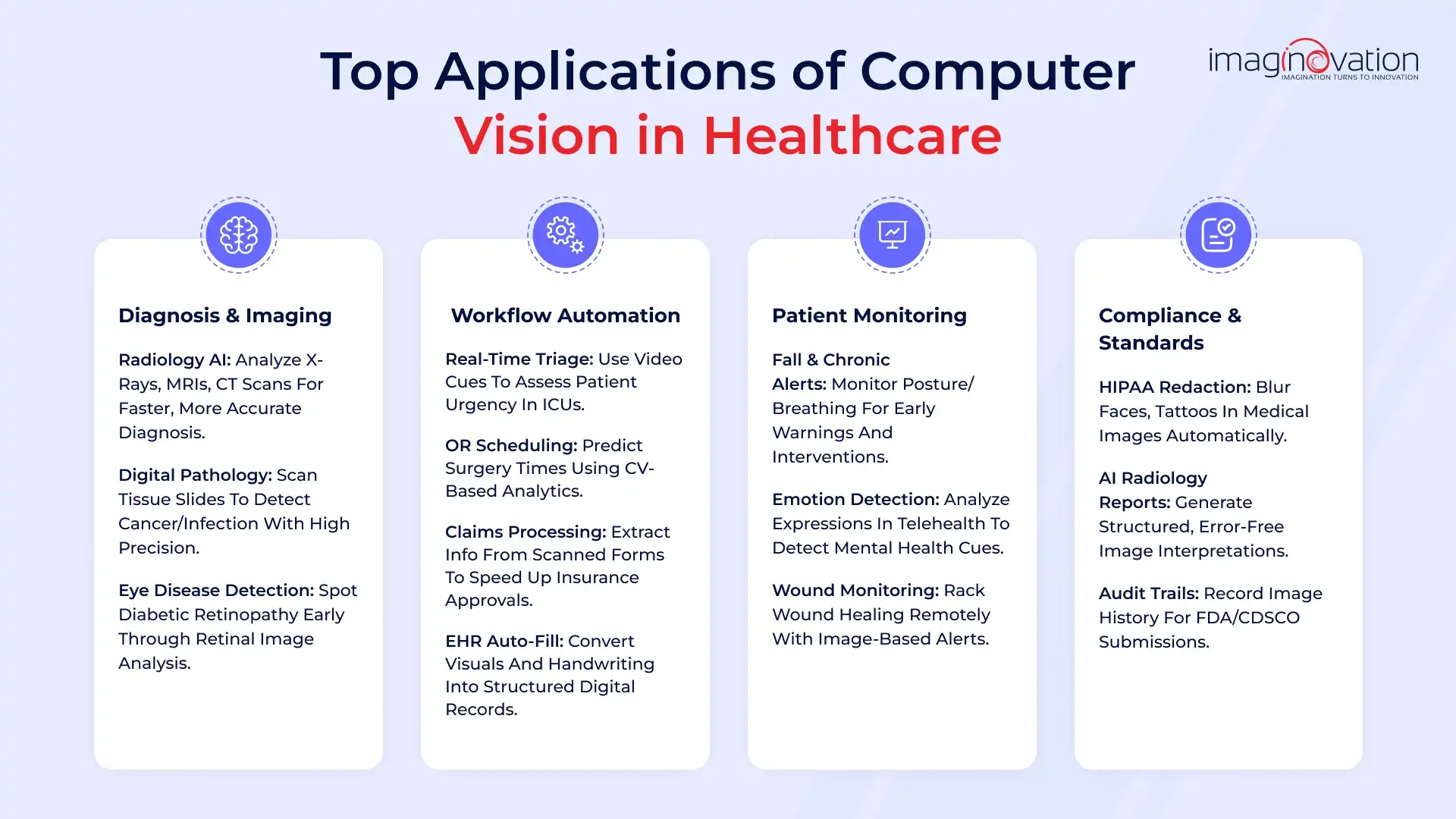
2. Workflow Automation
2.1 Real-time triage
Computer vision enables faster triage by analyzing visual cues, such as facial expressions, body posture, or vital signs, to assess patient urgency.
For example, CLEW utilizes CV and AI to monitor ICU patients in real-time, flagging early signs of deterioration and helping staff prioritize care.
2.2 OR scheduling optimization
Yet another application with CV is optimizing operating room schedules by analyzing video feeds and past procedure data to predict surgery durations and reduce downtime.
For example, Northwell Health utilizes CV-based systems to monitor operating room (OR) utilization, thereby improving scheduling accuracy and resource efficiency.
2.3 Insurance claims pre-processing
CV can also streamline claims by extracting key information from scanned documents and images. Google Cloud’s Document AI utilizes computer vision to automatically read forms, reducing manual entry, speeding up approvals, and lowering error rates in claims processing.
3.4 EHR auto-filling
Computer vision automates EHR entry by converting handwritten notes and diagnostic images into structured digital records.
For instance, Nuance DAX captures and processes visuals and speech from consultations, auto-filling EHRs to reduce clinician workload.
4. Patient Monitoring & Remote Care
4.1 Fall detection and chronic care alerts
CV applications help avert potential falls for elderly patients. They have fall detection systems that analyze real-time video to identify sudden movements or changes in posture. The insights can trigger instant alerts to caregivers for quick intervention.
Yet another area where CV apps are handy is in chronic conditions like COPD or heart failure, where vision systems can track visual cues, such as labored breathing or facial pallor, and send timely alerts for medical attention.
4.2 Emotion recognition in telepsychiatry
Computer vision (CV) techniques are helpful in the context of mental health care. During virtual therapy sessions, access to a wealth of facial expressions enables in-depth analysis and provides valuable insights.
For example, the video input can detect emotions such as sadness, anger, or anxiety in patients during telepsychiatry calls. These inputs can help healthcare providers monitor patients more accurately and respond promptly to signs of emotional distress.
4.3 Smart wound monitoring with visual tracking
This technology enables doctors to identify infections early. It helps track healing without constant in-person visits. With visual tracking backed by AI and CV, smart wound monitoring can analyze wound images over time.
For example, a diabetic patient can take daily photos of their wound through an app, and any unusual changes can alert doctors and prevent complications.
5. Compliance & Standardization
5.1 HIPAA-compliant image redaction
Computer vision can help ensure compliance with HIPAA regulations by automatically detecting and blurring personally identifiable features in medical images, such as faces, tattoos, or patient labels.
5.2 AI-generated structured radiology reports
It is also easy to analyze diagnostic images, such as X-rays or CT scans, and produce structured, standardized radiology reports.
The positive aspect is that it can reduce human error and help enhance diagnostic reliability.
5.3 Audit trails for FDA/CDSCO submissions
Yet another aspect of CV systems is that they can log every interaction with medical images.
The systems can help capture when, how, and by whom an image was acquired, modified, or reviewed. Thus, you can look out for a transparent audit trail for regulatory bodies like the FDA or CDSCO.
Strategic Benefits of Computer Vision in Healthcare
Beyond updating workflows, computer vision can deliver meaningful advantages that improve efficiency, quality, and patient outcomes.
Here are some of the most impactful benefits to consider:
1. Cost Savings
For any business leader, cost is a critical factor when planning to invest in technology. In this context, one of the most significant advantages of CV in healthcare is the cost savings it provides.
Hospitals can save both time and money by reducing the need for manual labor in repetitive diagnostic tasks.
Moreover, early detection of diseases means treatment can start sooner, which can help avoid expensive procedures later.
Another way to save costs is through predictive maintenance for imaging machines, which ensures they remain in good condition, reducing the likelihood of breakdowns and costly repairs.
2. Scalability
Another major advantage is the ability to scale efficiently across locations and care settings. CV models make it easier to extend advanced diagnostic and operational support wherever it’s needed.
A significant advantage of CV models is that they support scalable deployment. Thus, if you are looking to expand into rural and underserved areas, it will be easier with these models.
Moreover, there is no need for significant infrastructure overhauls, as the models are designed to function well across diverse and fragmented hospital IT environments.
3. Risk Mitigation
Reducing risks, both clinical and operational, is a core reason many healthcare organizations adopt computer vision.
Another key benefit of using a CV in healthcare is risk mitigation. It helps achieve more consistent and accurate results, thereby lowering medical errors. Thus, it also reduces the risk of malpractice claims.
Moreover, it makes quality assurance and audit processes easier by providing better documentation and traceability.
4. Team Optimization
CV can also help clinical teams work more effectively and focus their skills where they matter most.
In healthcare, CV can streamline routine workflows, enabling radiologists to focus on high-priority or complex cases. Meanwhile, nurses and technicians spend less time on administrative tasks. This leads to more efficient resource utilization, reduced burnout, and improved patient care.
In this context, Pete Peranzo, Co-founder of Imaginovation, shares:
"Computer vision and AI can significantly enhance healthcare operations by automating diagnostic processes, reducing human error, and freeing up valuable time for medical staff."
Pete shares an example:
"Similar to how VAR technology in soccer provides real-time error correction and improves decision accuracy, AI systems in healthcare, such as computer vision applied to MRI scans, can detect anomalies like tumors more quickly and accurately than manual review. This leads to faster diagnoses and more timely interventions."
Addressing Common Concerns Around Adoption
Even with clear benefits, many healthcare teams feel uncertain about adopting AI and computer vision. Addressing these concerns early is crucial for a smooth implementation and building trust.
1. Fear of False Positives
One concern is the fear of false positives, where AI incorrectly flags a problem, such as identifying a tumor that isn’t there.
This can cause stress, lead to extra tests, and even result in unnecessary treatment.
That’s why it’s essential to frame AI as a helpful assistant, not a replacement. It provides an extra set of eyes to support decisions while doctors remain in complete charge. When seen this way, trust grows.
2. Clinician Skepticism
Another challenge is hesitation from experienced clinicians who may feel their expertise is being questioned. Clear communication is key. AI is here to support their work, not compete with it.
Taking over routine tasks frees up time for deeper patient care. Real-life examples of AI improving outcomes can alleviate concerns and demonstrate how it enhances, rather than replaces, clinical judgment.
Computer Vision in Healthcare: Implementation Strategies for Minimal Disruption
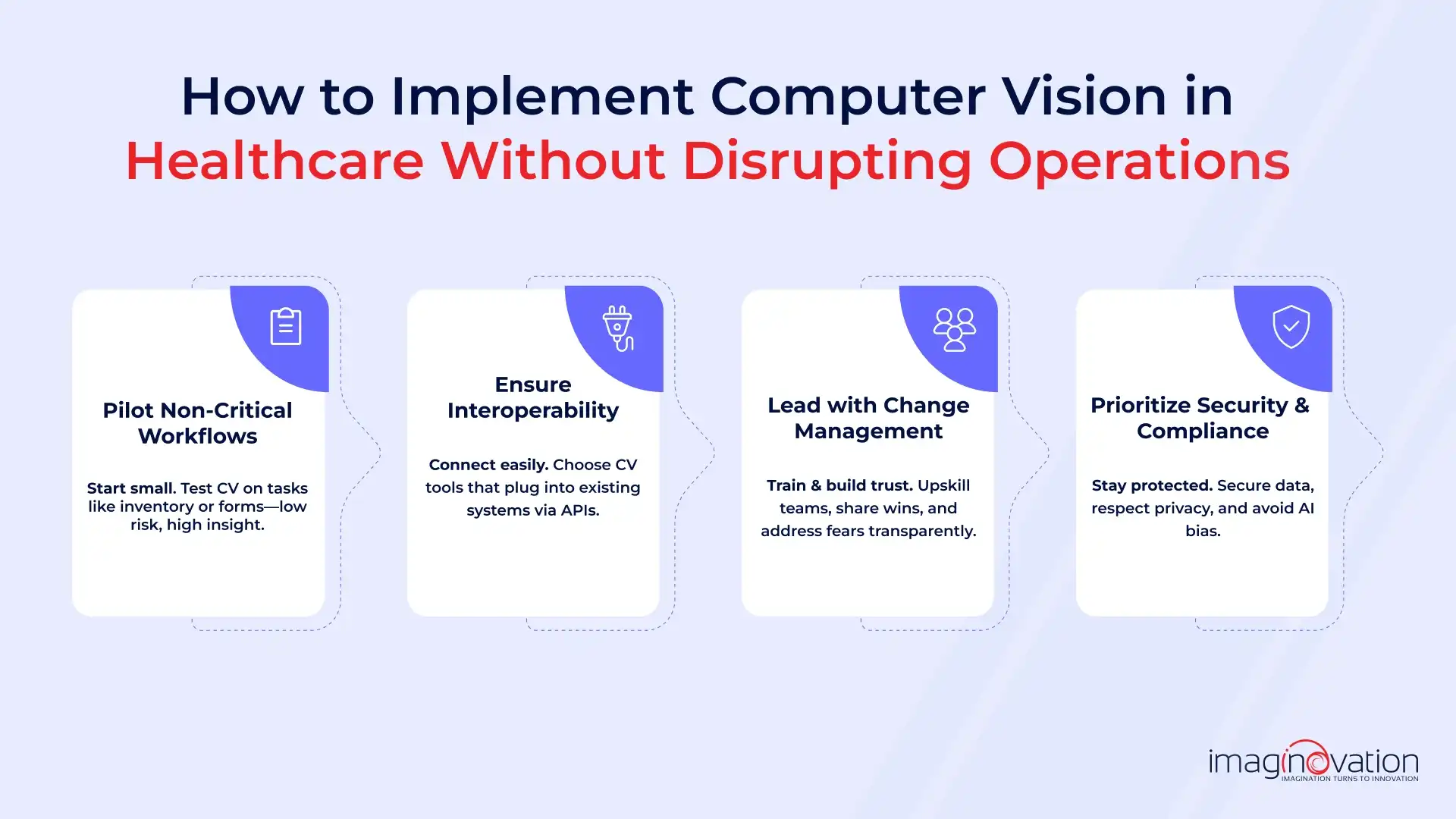
Rolling out computer vision across a healthcare organization takes more than just picking the right tools. A thoughtful implementation approach can help avoid workflow disruptions, build trust, and set your teams up for long-term success.
Below are a few practical strategies to guide a smooth transition:
1. Pilot Non-Critical Workflows First
Of course, you might be tempted to roll out new technology across the entire system right away. But before you do that, start small.
It’s often best to begin with non-critical tasks. For example, you can test computer vision by tracking inventory or scanning insurance documents, where mistakes won’t have serious consequences.
Plan for a silent pilot, which allows you to run the system in the background without affecting actual work. This approach helps you evaluate performance, spot any issues early, and determine whether the solution is ready for broader adoption.
2. Ensure Interoperability
You likely already have systems in place, such as image storage platforms (like DICOM or PACS) or electronic health records (EHRs), including Cerner, Epic, or custom solutions.
When you add new technology, such as CV, it’s essential to ensure it integrates smoothly with your existing workflows.
Look for solutions designed to connect easily without requiring you to rebuild everything from scratch.
Ideally, CV tools should offer APIs or connectors that integrate seamlessly with your current environment, allowing day-to-day operations to continue uninterrupted.
3. Build the Right Change Management Plan
Every new technology requires people to adapt.
A thoughtful change management plan can make this process much easier. Training is especially important to help teams understand how to work alongside AI tools rather than feel threatened by them.
Pete shares:
“AI helps clinicians find what they might miss, reducing misdiagnoses and helping organizations deliver better, faster care.”
Training should cover what the technology does, how it supports existing roles, and why it’s not meant to replace staff but to enhance their capabilities.
In addition to training, share clear results, like time saved or improved accuracy, during regular operations reviews. This helps build trust and demonstrates the return on investment.
Finally, be proactive in addressing any concerns about surveillance or job loss. Open communication and transparency are key to a smooth transition.
4. Prioritize Security and Compliance
When implementing computer vision, protecting sensitive data should always be a top priority.
Use secure storage options, whether on-premises, in the cloud, or a hybrid approach, and establish clear policies around access.
Pete highlights:
“The issue is more gonna be around compliance, like HIPAA compliance, and you know where the videos get stored and who has access to the videos, so the logistics around it would be more difficult than actually upgrading the software.”
It’s also essential to ensure AI models are trained on fair and diverse datasets to prevent bias.
This not only helps maintain compliance but also protects trust and ensures the technology works for everyone.
How to Measure the Success of Computer Vision Integration
Once computer vision tools are in place, it’s important to track their real-world impact.
The following metrics can help you evaluate whether your investment is delivering meaningful improvements in care, efficiency, and operations.
1. Diagnosis Time Reduction (%)
CV in healthcare is widely adopted because it reduces the time to diagnosis. Studies show reductions ranging from 61.57% to 99.13%.
A great way to measure the success of CV integration is to track how much faster diagnoses are made after CV is implemented.
CV algorithms can analyze medical images, such as X-rays, MRIs, and CT scans, much more quickly than humans, resulting in swifter diagnoses.
A shorter diagnosis time means patients receive answers and treatment sooner, directly improving the quality of care.
2. CV Model Accuracy vs. Clinician Baseline
Another way to measure success is to compare the accuracy of the CV tool to that of human clinicians.
If the CV model performs better or at the same level, it demonstrates that technology is adding real value without lowering standards.
In this context, CV models have demonstrated impressive accuracy in tasks such as detecting lesions in colonoscopy images, with some models reducing error rates from 20% to 3%.
The models are especially useful when working with large datasets or subtle patterns that are challenging for humans to detect.
3. Alerts Resolved Within SLA (Service Level Agreement)
To assess reliability and responsiveness, track how quickly CV-generated alerts are resolved compared to agreed-upon response times.
These insights help measure whether the system is accurate, usable, and effective in day-to-day workflows.
For example, if a hospital security team uses CV to detect intrusions, the SLA might require alerts to be addressed within 5 minutes.
Success can then be measured by how often this target is met, demonstrating both reliability and operational fit.
4. Staff Time Saved per Department
Measuring time savings across departments is another valuable indicator of success. CV tools often reduce manual work for teams in radiology, nursing, and administration.
For instance, if it typically takes 15 minutes to classify an image and a CV system can do it in 3 minutes, that’s a 12-minute saving per image.
This efficiency enables staff to allocate more time to patient care and other essential tasks.
5. Manual Error Reduction in Administrative Operations
Finally, examine the reduction in mistakes for tasks such as patient form processing or insurance data entry.
Fewer manual errors lead to smoother operations, fewer delays, and less rework.
What Forward-Looking Healthcare Ops Teams Are Building Toward
Healthcare operations teams are already thinking beyond current workflows.
Here are a few areas where innovators are exploring how computer vision can unlock the next level of care, efficiency, and sustainability:
1. Real-Time Surgical Assistance with CV Overlays
One area gaining traction is the use of computer vision to support surgeons during procedures through real-time visual overlays.
These overlays can highlight critical anatomy, guide each step of the surgery, and flag potential issues as they arise. The result is greater precision and enhanced safety in the operating room.
2. Outbreak Detection via Live Symptom Mapping
Early detection of outbreaks has become even more critical in the wake of the pandemic.
Computer vision can help by analyzing symptoms in real time, such as coughing, fever, or visible rashes, across large populations.
This enables public health teams to respond faster and contain potential outbreaks more effectively.
3. Ambient Monitoring for Silent Patient Care
Continuous monitoring can be stressful for patients if it’s intrusive. Many hospitals are adopting CV for passive observation that doesn’t disturb or alarm patients.
These systems can discreetly detect falls, signs of distress, or changes in vital signs, allowing staff to respond quickly while preserving patient dignity and comfort.
4. Sustainability via Edge Computing CV Models
Forward-thinking teams are also moving CV processing closer to where data is generated by leveraging edge computing.
This approach reduces reliance on cloud servers, cuts latency, and lowers energy consumption, all of which help shrink the environmental footprint while speeding up analysis.
What Makes Imaginovation the Go-To for Computer Vision
Choosing the right partner is just as important as choosing the right technology.
Imaginovation helps healthcare teams adopt computer vision with confidence. Our solutions integrate seamlessly with existing systems, avoiding costly overhauls.
With deep expertise, we build tailored models for oncology, imaging, and compliance workflows that deliver real results.
If you’re ready to explore what’s possible, let’s talk.
Ready to build an app, but not sure where to start?
We've got you covered. Click the button below to get started.

